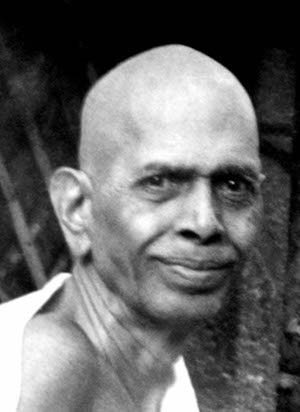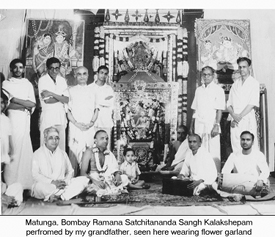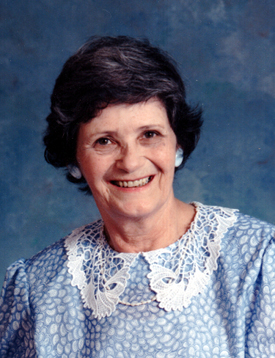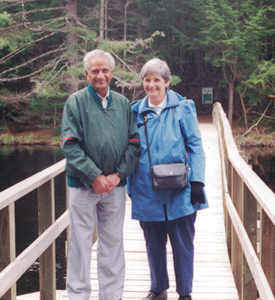The Holy Reminiscence
I saw Bhagavan Sri Ramana for the first time in my life during the memorable night of the 10th of December, 1949. I reached Sri Ramanashram in the evening and a very friendly and helpful monk of the Ashram informed me that I might be able to have darshan of the Maharshi from a distance that very night; I waited with bated breath for this rare privilege. Then, all of a sudden, I saw him as he slowly emerged from the bathroom, leaning heavily on the arms of two bhaktas.
I was simply astounded and thrilled by the vision before me. I saw a tall, lean man in loin cloth; his limbs were well-proportioned, well-knit and long; his skin was smooth and glowing and his quivering head was inclined towards the right side. There was a white bandage on the left arm, which had been operated upon to remove a tumor. His eyes were neither big nor small but clear, deep and mystical, and his clean-cut, handsome face was in perfect repose and serene tranquility. Intense physical suffering had not touched or intruded upon the sovereign realm of his soul. His eyes shone with kindness and love for all mankind; his face was lit up with a beatific smile of benediction. I saw before me a yogi of the highest order, a mystic of supreme realization, for he radiated the living presence of divinity within and without. Verily, such persons live and move and have their being in God alone.
The next morning I saw him again. Slowly and with a spirit of high expectancy I entered the spacious hall where he was giving darshan to the gathering. I sat down quietly in one corner after tendering my salutation which he promptly accepted by nodding his head slightly, smilingly. I saw around me rows of seated men and women of different races and religions, of different stations and positions. I saw European, Parsi, Muslim, Hindu gents and ladies sitting calmly in yogic asanas. In a big utensil the incense burned and suffused the air with a soothing aroma, while the silence was broken by the vibrant chanting of holy hymns by a few Ashram brahmacharins.
Almost at the center of the hall on an elevated, white bed sat the Maharshi. Only a white loin cloth was on his person; his right hand held a fan with which he fanned himself indifferently and infrequently. I saw the same quivering and slightly inclined head and in the clear morning the mystic lines of his face were deep and sharply drawn. His ever-smiling face was completely free from the ravages of the illness that was slowly and steadily devastating the body. His spiritual presence was dynamic and clearly perceptible. It touched and inspired us and simultaneously raised us to the high and rare sphere of spirituality. I felt suddenly the presence of a spiritual power which was ambient and edifying, and it raised the expectancy of all to a high pitch. The atmosphere of the hall was distinctly attuned to a higher will and power that influenced the entire gathering. All eyes were fixed on the Maharshi. Every soul was raised to a high spiritual level by the nearness and influence of his great yogic personality. I intensely reflected on this unique phenomenon and tried hard to find an answer to this unheard of event. I wanted to know how and by what irresistible force it had been possible for persons young and old, rich and poor, wise and simple, belonging to different races and religions, to gather at the feet of this great yogi. I wanted to know how and why stubborn diversity had become transformed into unity, the persistent dissimilarity into perfect harmony, the many into the One!
Suddenly the answer came and I realised that it had been possible solely due to the unifying presence and realization of the Maharshi. I realised that the Maharshi was the living embodiment of the Advaitic truths of Vedanta. He was the complete realization of the eternal truths of Vedanta – the truths which are ever universal and transcendental, harmonious and cohesive. And he was not only the preacher of unity and oneness, of identity of man and God, of spiritual brotherhood of mankind, irrespective of caste or creed, time or clime, race or position, but he was the living symbol of these truths, their perfect realization in real life. That was why his all-embracing personality had become the centre of universal truth and the unifying force cementing diverse races and religions into a harmonious concord. That was why hundreds of people of diverse conditions and ways, of different aspirations and hopes had gathered at his feet spontaneously to receive the benediction of peace, contentment and spiritual illumination.
A few days later I left Sri Ramanashram; my heart was full to the brim. But deep within I felt, just as all Ashram people felt, that the Maharshi would shortly cease to grace the earth by his physical presence. For, he was on the verge of departure.
Afterwards we heard over the radio that the sage had laid down his mortal coil on the 14th of April, 1950.
He has now passed away, but have we known him thoroughly and fully? Our narrow understanding cannot comprehend him: his greatness is too vast, too immense to be captured within our mental orbit. Just a part of his spiritual self – a tiny fraction of it is visible to us and we rejoice in this partial vision of him because we live in the dark and bound by the sad limitations of our senses. Though he has passed away, he lives perpetually in the evergreen memory of his thousands of devotees the world over, in his own undying gospels and messages which would surely continue to uplift, inspire and guide all along the right path towards the true and the highest goal – Self-realization.
Fixing the mind firmly on Brahman, the point of concentration, restraining the sense organs in their respective centers, holding the body steady and giving up all thoughts for its maintenance, attaining identity with Brahman and being One with it, continuously drink the bliss of Brahman in your own Self. Of what use are other things? They are entirely false, empty illusions.
Singing the Life of Bhagavan Ramana
My mother Santha Venkatramanan told me about five years ago that her father Embar Vijayaraghavachariar had met Bhagavan and had performed a Harikatha on Bhagavan’s life and teachings in Bombay. We then attempted to locate a recording of the performance but did not make much progress. I was told that ‘Sangeetha Kalanidhi’ Embar S. Vijayaraghavachariar (1909–1991), my grandfather, approached Bhagavan in 1944 to seek his permission to perform ‘Ramana Vijayam’. This is an art form of storytelling commonly called ‘Harikatha’.
Harikatha is a composite art involving storytelling and music which was originally pioneered in Maharashtra during the Bhakti Movement. In the early years, exponents of Harikatha, also known as Keerthankars in Maharashtra, primarily performed the stories found in well-known religious texts, such as the Ramayana and stories of Vithala of Pandarpur. The heritage was brought to Tamiḷ Nadu by the Maharashtrian Kings of Tanjavur and brilliantly developed into a major art form by doyens[1] like Thanjavur Krishna Bhagavathar, Mangudi Chidambara Bhagavathar, Embar Srirangachariar (my great grandfather), Embar Vijayaraghavachariar (my grandfather) and other artists. In Tamiḷ Nadu, Carnatic music was weaved into the art form with focus on stories of the Alwars and Nayanmars. Embar, as he was fondly addressed, was then living in Mannargudi.
My grandfather was said to have gone to Tiruvannamalai to request permission to perform the life story of Bhagavan and take his blessings. We did find an audio copy of an All India Radio interview with Embar Vijayaraghavachariar, recorded many years later wherein he says, “I think it was in 1944 – Ramana Bhagavan was there then – a Sabha in Bombay asked me if I can do ‘Ramana Vijayam’ as Kalakshepam. I told them that Bhagavan was yet alive and was not sure if it would be appropriate. I said I would go and ask his permission. Then I went with one of my brothers to Tiruvannamalai. I did Namaskaram and conveyed to him that a Sabha in Bombay wanted me to perform ‘Ramana Vijayam’ and would be grateful if Bhagavan were to give his permission.
Bhagavan’s response was, ‘What is the hurry in doing this now?’ I said, ‘When Rama was alive, Kusa and Lava sang Ramayana and I would be happy if I could also do ‘Ramana Vijayam’ when Bhagavan is still here in this world, and hope that Bhagavan can also listen to it one day.’ Bhagavan said, ‘Sure, do it as much as you want.’ Then I performed his story many times after that.”
We found among our old photos one taken after the Kalakshepam in Matunga, Bombay.
About the same time, my mother received a copy of a Tamiḷ book on Harikatha and the most talented performers of this art form. Embar and his father’s life history are documented in great detail in the book, including a mention of the family’s connection with Bhagavan and Embar’s visit to Bhagavan in 1944.
Just recently we also found that this event is mentioned in Day by Day with Bhagavan:
30-12-45
Afternoon
A devotee brought and gave to Bhagavan a cutting from The Bombay Chronicle in which an account was given of how Ramana Jayanti was celebrated this year at Matunga, Bombay, by the Ramana Satchidananda Sangh and how one Vijayaraghava Bhagavatar of Mannargudi and his party performed an excellent kalakshepam on Bhagavan and his life and teachings. The cutting was read out in the hall for the benefit of all. It said that a harikatha was held on Ramana. Bhagavan said, “Harikatha on Ramana is a misnomer. Kalakshepam would have been more appropriate.”
Embar had the unique privilege of being the first person to perform Harikatha on the lives of Seshadri Swamigal and Ramana Maharishi. His father Srirangachariar is known to have been associated with Mahan Seshadri Swamigal and Bhagavan Ramana Maharishi. Embar, who was born a Vaishnavaite in the lineage of Ramanuja’s direct disciple, was known for popularizing the stories of Saivaite saints, and his performance on Periyapuraanam and Nandan Charitram is said to remain unsurpassed even to this day.
[About the Day by Day with Bhagavan book reference, Badri, Hema’s husband, writes:]
On July 11, 2015, we were at the New York Ashram. I was sitting in the living room and saw a copy of the Day by Day with Bhagavan laid out flat on the big book shelf. I casually opened the book and a post-it fell out from it.
I attempted to put the bookmark back, and as I did, I glanced at the very first paragraph. It was the record about Bhagavan and devotees reading an article of the Bombay Chronicle about a Harikatha on Ramana Maharishi that had been performed by Mannargudi Vijayaraghavan (popularly known as Embar Vijayaraghavachariar) in Bombay!
What do we call this? Nothing but Grace. We had been searching for an audio recording of the “Ramana Vijayam” event for many years and I consider it was nothing but Bhagavan’s grace that made me stumble upon that very page in the book about it – and that too when I was in the NY Ashram.
On the same day, we shared this event with the devotees present, and had a lively discussion on the topic of Grace and inexplicable events that seem to just to “happen” coincidentally. This furthers my belief that Ramana Maharishi, although not presently with us in human form, is still guiding our spiritual progress ever so mysteriously.
Who knows, in the future, we might even find the audio recording drop onto our lap just like the post-it – all by Ramana Bhagavan’s grace!
Two poems by Robert Paul Saphier
Robert Paul Saphier left us only a short year ago. From his abode of silence surfaced two brief poems, reflecting on the inner path walked in meditation with his friends of Arunachala Ashrama.
The Journey
Expanse of infinite field
Beyond the archaic wall –
And friends gather for a journey
We evoke an ever-present prayer –
Flowing wakeful guidance;
Undistracted, seek the One
Whose prayer sustained is true abidance.
We invoke an ever-present faith –
Flowing wakeful fervence;
Undistracted, seek the One
Whose faith sustained is true observance.
Together we shall rise and fall,
Traversing turbulent terrain:
Travelers seeking the One Seer
Whence conflict past shall be not-retained.
Expanse of infinite field
Beyond the archaic wall –
And friends gather for a journey
Untitled
An oft told tale
A golden awakening
Pointing the error
Of mistaken identity.
Here is always here
No veil to uncover
No theory to exhale –
Radiance in the Home.
Dorothy E. Hartel
On Monday, May 18, 2015, in Tonawanda, New York, Dorothy Elizabeth Hartel peacefully slid out of her mortal frame into eternity. She was 95.
Born amidst a multi-ethnic community alongside the busy harbors of New York City, she and her four siblings were raised by their Irish mother during the Great Depression. The lessons learned during those trying times broadened her heart and strengthened her character. After high school she began working to help support the family, commuting between Bayonne, New Jersey and Manhattan to the Consolidated Edison Building on 14th Street where she was employed. During World War II she volunteered to sell War Bonds and join committees to support locally-stationed servicemen. That is how she met and married a Marine from Tonawanda, NY who was recovering from a combat wound at the Brooklyn Navy Yard.
Many devotees and friends of Arunachala Ashrama in New York and Nova Scotia, Canada fondly remember meeting her — some, many times — since she first visited the Nova Scotia Ashram in 1972, the year it opened. Every year for the next forty years she said her life felt incomplete unless she spent at least a month or two at the Nova Scotia Ashram.
During the 1970s and 80s she would routinely quit her job and drive up to the Nova Scotia Ashram for the summer. And every September, without fail, her employer would eagerly await her return to rehire her.
In later years, when she was unable to make the long journey alone, one of her two sons, James or Dennis, would drive her there. Dennis is a founding member of the Nova Scotia Ashram.
In the Ashram, children and adults all felt at home in her presence. She cheerfully participated in Ashram projects, like cooking for guests, cleaning, decorating, etc. And although a devout Catholic, she found no conflict in the Ashram surroundings and spiritual practices. She understood that there was only one Source, one God in the hearts of all beings and that each individual is different and must seek fulfillment in their own way.
Mrs. Hartel remained cheerful and comfortable throughout her final years in the home in which she lived for 64 years, and where she ultimately died. She was predeceased in 2013 by both her husband Kenneth and eldest son, Kenneth, Jr.
During her period of decline, many friends and devotees from Arunachala Ashrama and elsewhere graciously took the time to visit her and also made the trip after her passing to attend her funeral. A multitude of devotees and friends reached out to express their sincere condolences and support, for which all her family members were extremely grateful.
What follows is the eulogy given by Dennis at her funeral mass in the St.Francis of Assisi chapel in Tonawanda, New York:
All of us here today have one unique life experience in common: we all have or had a Mother.
From the time of conception, a mother’s mind automatically turns to her child. She dedicates the best years of her life to promoting the welfare and happiness of her child. She continuously sacrifices without expectation of return. It is love for the sake of love; it is a selfless love. The closest expression that we have on earth to the universal love of God is the pure reflection of God’s love emanating from the heart of a Mother.
That is why in the Bible, one of the Ten Commandments tells us we should honor our mother. And in other scriptures around the world, this same theme of honoring the Mother is evoked. One such verse, known to perhaps a billion people, goes:
Matṛ Devō Bhava, Pitṛ Devō Bhava, Guru Devō Bhava, Atithi Devō Bhava.
“Let your mother be a god to you; let your father be a god to you; let your guru be a god to you; let your guest be a god to you.” Here, Mother holds the first place above all.
The edict in this verse that I learned many years ago has always been easy for me to practice because of the Mother I was destined to have. I could easily understand why it is the Mother who holds the first place above the father, the teacher, and the guest.
I, my brothers and sister, their children and our friends all have many wonderful memories of Mother or Grandma. After all, she lived for 95 years, and we had plenty of opportunities to experience them. I would never have enough time here to recount them. All of you have your own memories to cherish and live by, and I have mine.
While we were young she worked tirelessly to keep us on the straight and narrow path. But once we reached maturity, she cut us loose. She wanted us to be strong and to stand on our own two feet. Whenever we discussed with her what path in life we wished to take, she would say, “If you really believe that this will make you happy, I want you to do it.” And once we did, she always supported and encouraged us, and even actively helped us in many ways.
She was a constant encouraging force of love for all members of her extended family, completely without judgment. This love would immediately be evident whenever one of us walked into her room.
She would spontaneously greet us with a beaming smile, that same warm, affectionate smile that she would give us when we first saw her after, perhaps, a year’s absence. But sometimes, it wasn’t a year’s absence. We would only be gone an hour. And she would greet us like this every day! Numerous times!And none of us can ever forget the genuine gratitude she always expressed for even the slightest attention or service given to her.
This embodies what Mother is to me. It is something I will never forget and I will always miss.
A famous poet[2] wrote: “Death is not extinguishing the light; it is only putting out the lamp because the dawn has come.”
On Monday morning, we, her three children, held her hands as she silently stepped into that light of dawn. And for this, we feel blessed and will be forever grateful.
Advent at Arunachala
You, your family and friends are cordially invited to join us in celebrating the
119th Anniversary of Sri Ramana Maharshi’s Advent at Arunachala.
The programs will include parayanams, bhajans, talks and puja,
followed by prasad (lunch).
In
Queens, New York City
Saturday 12 September — 11:00 AM
Arunachala Ashrama
86-06 Edgerton Blvd., Jamaica Estates,
New York 11432 / Tel: 718.560.3196
In
Nova Scotia, Canada
Sunday 6 September — 11:00 AM
Arunachala Ashrama
1451 Clarence Road, Bridgetown,
Nova Scotia B0S 1C0 / Tel: 902.665.2090
In California,
San Francisco Bay Area
Saturday 19 September — 11:00 AM
40086 Paseo Padre Pkwy, Fremont, CA 94538
Tel: 510-656-2752
Camping Satsang
On July 25th at 11 AM devotees from Northern New York State, New York City, Ottawa and Toronto joined together to celebrate the first ever ‘Camping Satsang’ in the Thousand Islands – given that name in honor of the few devotees determined to sleep out under the stars. The gathering was held at the home of Evelyn Saphier in Hammond, NY and conducted in the newly-renovated 19th Century barn, reminiscent of the first Advent Celebration which was held in the barn of the Nova Scotia Arunachala Ashrama in 1974.
Those devotees who were able to stay overnight rose early for Veda Parayana, Reading, chanting of Sri Lalita Sahasranam Stotram and Silence, in a schedule similar to that held at the Ashrams in Nova Scotia and New York. Devotees also enjoyed a pilgrimage to Vivekananda Cottage and Vivekananda Rock, and some took a refreshing dip in the St. Lawrence River by the public dock on Wellesley Island where Vivekananda, on departing, proclaimed: “I bless these Thousand Islands.” This grand gathering of sincere devotees and friends both old and new was, indeed, a descent of grace divine!






